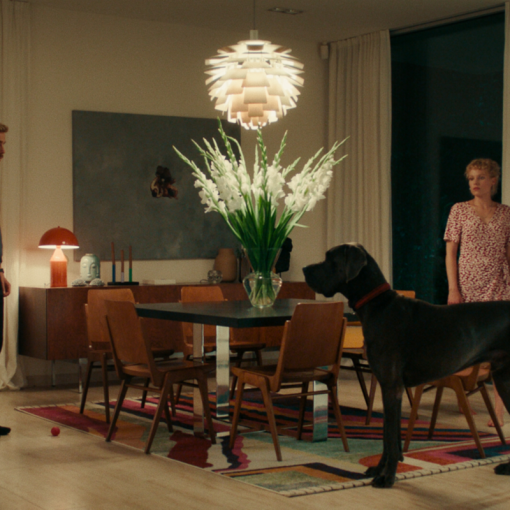 “There are some great female voices around now, but I’m not one of them, and I wish I was…” states Shirley Collins, sadly, on the opening of the LP to the sound of bonfire sparks, following it sincerely with “…but I believe when I was singing at my best I was the essence of English song. That I sang it better than anyone else, understood it better than anybody else and really that was all I ever wanted”.
“There are some great female voices around now, but I’m not one of them, and I wish I was…” states Shirley Collins, sadly, on the opening of the LP to the sound of bonfire sparks, following it sincerely with “…but I believe when I was singing at my best I was the essence of English song. That I sang it better than anyone else, understood it better than anybody else and really that was all I ever wanted”.
A statement that embodies this documentary as Shirley humbly recollects the past to wander out the other side a more confident artist. The warmth of the Sussex countryside and people surrounding her bleeding into the high and lows, the childhood reminisces, something both the LP and DVD are umbilically tied to.
Chronologically laden, but never regimented, the anarchic spectacle of the Lewes firework celebrations grabs at your imagination then fades to a trip to London’s Troubadour pub. The bohemian coffeehouse of the 1950-60s folk revolution that has comedian Stewart Lee investigating Shirley’s early involvement with the scene. He plays her a clip of a candle-lit rendition of “Calvary Hill” she performed way back at the start of her career; “other lifetime stuff, isn’t it?” she forlornly remarks.It spurs on to her involvement with Alan Lomax (“a bison of a man”, describes Shirley) and his late fifties Southern states road trip to record his Archive of American Folk Song. An experience that harboured many an intimate touchstone that even now still reverberates the folk world. It’s a trip blighted by injustice, poverty and the prejudice they saw, things that made Shirley’s optimism “flee like pigeons from a cat”. The use of faux monochrome reconstructions (filmed entirely in Sussex and something that the DVD’s extras explain in greater detail) could have been the film’s downfall here, but they surprisingly heighten the story, positively stitch the patchwork of reminiscences and associated audio (that’s captured beautifully on the record too) into a cohesive whole. Rather than watching tape rotate, they grab convincingly at the era in vintage scratchiness, bend succulently to Shirley’s love of imperfection. They weave in and out of the story, attentively check against any lag in momentum, buoyantly bounce to the dialogue.
Hearing her recount the heartbreak of Hutchings‘ betrayal and the complete loss of her singing voice was almost too painful to watch, the parade of unsatisfying jobs that followed until she hit sixty and she was “finally free”. The death of her sister weighing heavy on your heart, poetically introduced by a blink or you’ll miss it flash of light over the cobbles. The tears that fall on hearing Dolly‘s last harpsichord composition re-played.
The sense of time and place is superbly evocative, perspires inspiration, lifts off the pages of the library of folksongs that line Shirley’s cottage. The explosive paganism of Hastings’s Jack in the Green festival vividly sparks in — like some modern day Wicker Man — the screen full of snappy horses and absinthed blurs. A green-faced David Tibet bumping into Shirley on the hill, later splicing into a cosy chat with her from his emporium. The camera panning out as he dusts his Anthem In Eden ceramic hanging above them (love his gold nail varnish). The informality and admiration that beams between them lovingly rendered, the lens warming to the mellow minutiae that tie up the conversation, skips off each other’s laughter to have a nosey around. Tibet’s affection for her “truthful voice” singing out, a passion that has brought Shirley back from retirement and into the arms of an entirely new audience.
Incidentally, away from the main meal, one of the (many) DVD extras here documents her surprise 2014 outing supporting Current 93 concert at London’s Union Chapel. The nervousness of before, the full two-song set and the exhaling relief of afterwards is a real treat for me to relive (I even have a go at spotting my stupid grinning face as the camera pans the audience).
They listen back on the third and final session and it sounds amazing, the camera panning to Shirley quietly singing along in approval from the comfort of the sofa. (I’m really embarrassed that I haven’t snagged myself a copy, especially after seeing this — something I need to remedy tout suite). An enchanting experience that ends on a banjo-backed studio clear up, Stephen and company leaving to a “too-da-loo, dears” from Shirley as she closes her front door.
The film closing on Shirley nested between two spitting braziers singing with a renewed confidence, a self-assured smile of pleasure breaking between verses, beautifully accompanied by Ian Kearey’s glinting pyrotechnics and Brown’s hurdy gurdy. A time machine transporting you from the twenty-first century to an England of olde, Shirley Collins the conjugate between the two.-Michael Rodham-Heaps-



